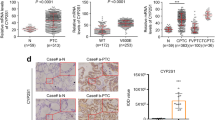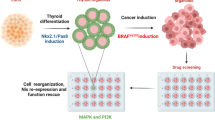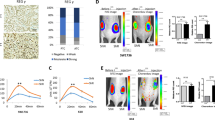Abstract
The BRAFV600E mutation is found in approximately 40% of papillary thyroid cancers (PTC). Mice with thyroid-specific expression of BrafV600E (TPO–BrafV600E) develop PTC rapidly with high levels of serum thyroid-stimulating hormone (TSH). It is unclear to what extent the elevated TSH contributes to tumor progression. To investigate the progression of BrafV600E-induced PTC (BVE–PTC) under normal TSH, we transplanted BVE–PTC tumors subcutaneously into nude and TPO–BrafWT mice. Regression of the transplanted tumors was observed in both nude and TPO–BrafWT mice. They were surrounded by heavy lymphocyte infiltration and oncogene-induced senescence (OIS) was demonstrated by strong β-gal staining and absence of Ki-67 expression. In contrast, BVE–PTC transplants continued to grow when transplanted into TPO–BrafV600E mice. The expression of Trp53 was increased in tumor transplants undergoing OIS. Trp53 inactivation reversed OIS and enabled tumor transplants to grow in nude mice with characteristic cell morphology of anaplastic thyroid cancer (ATC). PTC-to-ATC transformation was also observed in primary BVE–PTC tumors. ATC cells derived from Trp53 knockout tumors had increased PI3K/AKT signaling and became resistant to BrafV600E inhibitor PLX4720, which could be overcome by combined treatment of PI3K inhibitor LY294002 and PLX4720. In conclusion, BVE–PTC progression could be contained via p53-dependent OIS and TSH is a major disruptor of this balance. Simultaneous targeting of both MAPK and PI3K/AKT pathways offer a better therapeutic outcome against ATC. The current study reinforces the importance of rigorous control of serum TSH in PTC patients.
This is a preview of subscription content, access via your institution
Access options
Subscribe to this journal
Receive 50 print issues and online access
$259.00 per year
only $5.18 per issue
Buy this article
- Purchase on Springer Link
- Instant access to full article PDF
Prices may be subject to local taxes which are calculated during checkout





Similar content being viewed by others
References
Davies L, Welch HG . Increasing incidence of thyroid cancer in the United States, 1973-2002. JAMA 2006; 295: 2164–2167.
Hundahl SA, Fleming ID, Fremgen AM, Menck HR . A National Cancer Data Base report on 53,856 cases of thyroid carcinoma treated in the U.S., 1985-1995 [see commetns]. Cancer 1998; 83: 2638–2648.
Cooper DS, Doherty GM, Haugen BR, Kloos RT, Lee SL, Mandel SJ et al. Revised American Thyroid Association management guidelines for patients with thyroid nodules and differentiated thyroid cancer. Thyroid 2009; 19: 1167–1214.
Mazzaferri EL, Kloos RT . Clinical review 128: Current approaches to primary therapy for papillary and follicular thyroid cancer. J Clin Endocrinol Metab 2001; 86: 1447–1463.
Hollenbeak CS, Boltz MM, Schaefer EW, Saunders BD, Goldenberg D . Recurrence of differentiated thyroid cancer in the elderly. Eur J Endocrinol 2013; 168: 549–556.
Durante C, Haddy N, Baudin E, Leboulleux S, Hartl D, Travagli JP et al. Long-term outcome of 444 patients with distant metastases from papillary and follicular thyroid carcinoma: benefits and limits of radioiodine therapy. J Clin Endocrinol Metab 2006; 91: 2892–2899.
Xing M . BRAF mutation in thyroid cancer. Endocr Relat Cancer 2005; 12: 245–262.
Romei C, Ciampi R, Faviana P, Agate L, Molinaro E, Bottici V et al. BRAFV600E mutation, but not RET/PTC rearrangements, is correlated with a lower expression of both thyroperoxidase and sodium iodide symporter genes in papillary thyroid cancer. Endocr Relat Cancer 2008; 15: 511–520.
Durante C, Puxeddu E, Ferretti E, Morisi R, Moretti S, Bruno R et al. BRAF mutations in papillary thyroid carcinomas inhibit genes involved in iodine metabolism. J Clin Endocrinol Metab 2007; 92: 2840–2843.
Haymart MR, Glinberg SL, Liu J, Sippel RS, Jaume JC, Chen H . Higher serum TSH in thyroid cancer patients occurs independent of age and correlates with extrathyroidal extension. Clin Endocrinol (Oxf) 2009; 71: 434–439.
Boelaert K, Horacek J, Holder RL, Watkinson JC, Sheppard MC, Franklyn JA . Serum thyrotropin concentration as a novel predictor of malignancy in thyroid nodules investigated by fine-needle aspiration. J Clin Endocrinol Metab 2006; 91: 4295–4301.
Fiore E, Rago T, Provenzale MA, Scutari M, Ugolini C, Basolo F et al. Lower levels of TSH are associated with a lower risk of papillary thyroid cancer in patients with thyroid nodular disease: thyroid autonomy may play a protective role. Endocr Relat Cancer 2009; 16: 1251–1260.
Jonklaas J, Nsouli-Maktabi H, Soldin SJ . Endogenous thyrotropin and triiodothyronine concentrations in individuals with thyroid cancer. Thyroid 2008; 18: 943–952.
Knauf JA, Ma X, Smith EP, Zhang L, Mitsutake N, Liao XH et al. Targeted expression of BRAFV600E in thyroid cells of transgenic mice results in papillary thyroid cancers that undergo dedifferentiation. Cancer Res 2005; 65: 4238–4245.
Franco AT, Malaguarnera R, Refetoff S, Liao XH, Lundsmith E, Kimura S et al. Thyrotrophin receptor signaling dependence of Braf-induced thyroid tumor initiation in mice. Proc Natl Acad Sci USA 2011; 108: 1615–1620.
Charles RP, Iezza G, Amendola E, Dankort D, McMahon M . Mutationally activated BRAF(V600E) elicits papillary thyroid cancer in the adult mouse. Cancer Res 2011; 71: 3863–3871.
Shimamura M, Nakahara M, Orim F, Kurashige T, Mitsutake N, Nakashima M et al. Postnatal expression of BRAFV600E does not induce thyroid cancer in mouse models of thyroid papillary carcinoma. Endocrinology 2013; 154: 4423–4430.
Michaloglou C, Vredeveld LC, Soengas MS, Denoyelle C, Kuilman T, van der Horst CM et al. BRAFE600-associated senescence-like cell cycle arrest of human naevi. Nature 2005; 436: 720–724.
Dhomen N, Reis-Filho JS, da Rocha Dias S, Hayward R, Savage K, Delmas V et al. Oncogenic Braf induces melanocyte senescence and melanoma in mice. Cancer Cell 2009; 15: 294–303.
Fiore E, Vitti P . Serum TSH and risk of papillary thyroid cancer in nodular thyroid disease. J Clin Endocrinol Metab 2012; 97: 1134–1145.
Boelaert K . The association between serum TSH concentration and thyroid cancer. Endocr Relat Cancer 2009; 16: 1065–1072.
Fiore E, Rago T, Provenzale MA, Scutari M, Ugolini C, Basolo F et al. L-thyroxine-treated patients with nodular goiter have lower serum TSH and lower frequency of papillary thyroid cancer: results of a cross-sectional study on 27 914 patients. Endocr Relat Cancer 2010; 17: 231–239.
Natori T, Sata M, Washida M, Hirata Y, Nagai R, Makuuchi M . G-CSF stimulates angiogenesis and promotes tumor growth: potential contribution of bone marrow-derived endothelial progenitor cells. Biochem Biophys Res Commun 2002; 297: 1058–1061.
Li X, Yang Q, Yu H, Wu L, Zhao Y, Zhang C et al. LIF promotes tumorigenesis and metastasis of breast cancer through the AKT-mTOR pathway. Oncotarget 2014; 5: 788–801.
Fujisawa T, Joshi BH, Puri RK . IL-13 regulates cancer invasion and metastasis through IL-13Ralpha2 via ERK/AP-1 pathway in mouse model of human ovarian cancer. Int J Cancer 2012; 131: 344–356.
Hagemann T, Robinson SC, Thompson RG, Charles K, Kulbe H, Balkwill FR . Ovarian cancer cell-derived migration inhibitory factor enhances tumor growth, progression, and angiogenesis. Mol Cancer Ther 2007; 6: 1993–2002.
Kollmar O, Junker B, Rupertus K, Scheuer C, Menger MD, Schilling MK . Liver resection-associated macrophage inflammatory protein-2 stimulates engraftment but not growth of colorectal metastasis at extrahepatic sites. J Surg Res 2008; 145: 295–302.
Yoshimura T, Howard OM, Ito T, Kuwabara M, Matsukawa A, Chen K et al. Monocyte chemoattractant protein-1/CCL2 produced by stromal cells promotes lung metastasis of 4T1 murine breast cancer cells. PLoS One 2013; 8: e58791.
Zhou BP, Liao Y, Xia W, Zou Y, Spohn B, Hung MC . HER-2/neu induces p53 ubiquitination via Akt-mediated MDM2 phosphorylation. Nat Cell Biol 2001; 3: 973–982.
Cheng JC, Auersperg N, Leung PC . Inhibition of p53 induces invasion of serous borderline ovarian tumor cells by accentuating PI3K/Akt-mediated suppression of E-cadherin. Oncogene 2011; 30: 1020–1031.
Courtois-Cox S, Jones SL, Cichowski K . Many roads lead to oncogene-induced senescence. Oncogene 2008; 27: 2801–2809.
Serrano M, Lin AW, McCurrach ME, Beach D, Lowe SW . Oncogenic ras provokes premature cell senescence associated with accumulation of p53 and p16INK4a. Cell 1997; 88: 593–602.
Wei S, Sedivy JM . Expression of catalytically active telomerase does not prevent premature senescence caused by overexpression of oncogenic Ha-Ras in normal human fibroblasts. Cancer Res 1999; 59: 1539–1543.
Braig M, Lee S, Loddenkemper C, Rudolph C, Peters AH, Schlegelberger B et al. Oncogene-induced senescence as an initial barrier in lymphoma development. Nature 2005; 436: 660–665.
Chen Z, Trotman LC, Shaffer D, Lin HK, Dotan ZA, Niki M et al. Crucial role of p53-dependent cellular senescence in suppression of Pten-deficient tumorigenesis. Nature 2005; 436: 725–730.
Courtois-Cox S, Genther Williams SM, Reczek EE, Johnson BW, McGillicuddy LT, Johannessen CM et al. A negative feedback signaling network underlies oncogene-induced senescence. Cancer Cell 2006; 10: 459–472.
Sarkisian CJ, Keister BA, Stairs DB, Boxer RB, Moody SE, Chodosh LA . Dose-dependent oncogene-induced senescence in vivo and its evasion during mammary tumorigenesis. Nat Cell Biol 2007; 9: 493–505.
Di Cristofano A, Pesce B, Cordon-Cardo C, Pandolfi PP . Pten is essential for embryonic development and tumour suppression. Nat Genet 1998; 19: 348–355.
Collado M, Gil J, Efeyan A, Guerra C, Schuhmacher AJ, Barradas M et al. Tumour biology: senescence in premalignant tumours. Nature 2005; 436: 642.
Vizioli MG, Possik PA, Tarantino E, Meissl K, Borrello MG, Miranda C et al. Evidence of oncogene-induced senescence in thyroid carcinogenesis. Endocr Relat Cancer 2011; 18: 743–757.
Fagin JA, Matsuo K, Karmakar A, Chen DL, Tang SH, Koeffler HP . High prevalence of mutations of the p53 gene in poorly differentiated human thyroid carcinomas. J Clin Invest 1993; 91: 179–184.
Malaguarnera R, Vella V, Vigneri R, Frasca F . p53 family proteins in thyroid cancer. Endocr Relat Cancer 2007; 14: 43–60.
Dankort D, Filenova E, Collado M, Serrano M, Jones K, McMahon M . A new mouse model to explore the initiation, progression, and therapy of BRAFV600E-induced lung tumors. Genes Dev 2007; 21: 379–384.
Vizioli MG, Santos J, Pilotti S, Mazzoni M, Anania MC, Miranda C et al. Oncogenic RAS-induced senescence in human primary thyrocytes: molecular effectors and inflammatory secretome involved. Oncotarget 2014; 5: 8270–8283.
Alimonti A, Nardella C, Chen Z, Clohessy JG, Carracedo A, Trotman LC et al. A novel type of cellular senescence that can be enhanced in mouse models and human tumor xenografts to suppress prostate tumorigenesis. J Clin Invest 2010; 120: 681–693.
Yeager N, Klein-Szanto A, Kimura S, Di Cristofano A . Pten loss in the mouse thyroid causes goiter and follicular adenomas: insights into thyroid function and Cowden disease pathogenesis. Cancer Res 2007; 67: 959–966.
Antico Arciuch VG, Russo MA, Dima M, Kang KS, Dasrath F, Liao XH et al. Thyrocyte-specific inactivation of p53 and Pten results in anaplastic thyroid carcinomas faithfully recapitulating human tumors. Oncotarget 2011; 2: 1109–1126.
McFadden DG, Vernon A, Santiago PM, Martinez-McFaline R, Bhutkar A, Crowley DM et al. p53 constrains progression to anaplastic thyroid carcinoma in a Braf-mutant mouse model of papillary thyroid cancer. Proc Natl Acad Sci USA 2014; 111: E1600–E1609.
Zou M, Baitei EY, Alzahrani AS, BinHumaid FS, Alkhafaji D, Al-Rijjal RA et al. Concomitant RAS, RET/PTC, or BRAF mutations in advanced stage of papillary thyroid carcinoma. Thyroid 2014; 24: 1256–1266.
Xue W, Zender L, Miething C, Dickins RA, Hernando E, Krizhanovsky V et al. Senescence and tumour clearance is triggered by p53 restoration in murine liver carcinomas. Nature 2007; 445: 656–660.
Charles RP, Silva J, Iezza G, Phillips WA, McMahon M . Activating BRAF and PIK3CA mutations cooperate to promote anaplastic thyroid carcinogenesis. Mol Cancer Res 2014; 12: 979–986.
Freeman DJ, Li AG, Wei G, Li HH, Kertesz N, Lesche R et al. PTEN tumor suppressor regulates p53 protein levels and activity through phosphatase-dependent and -independent mechanisms. Cancer Cell 2003; 3: 117–130.
Mayo LD, Dixon JE, Durden DL, Tonks NK, Donner DB . PTEN protects p53 from Mdm2 and sensitizes cancer cells to chemotherapy. J Biol Chem 2002; 277: 5484–5489.
Rosivatz E, Matthews JG, McDonald NQ, Mulet X, Ho KK, Lossi N et al. A small molecule inhibitor for phosphatase and tensin homologue deleted on chromosome 10 (PTEN). ACS Chem Biol 2006; 1: 780–790.
Vassilev LT, Vu BT, Graves B, Carvajal D, Podlaski F, Filipovic Z et al. In vivo activation of the p53 pathway by small-molecule antagonists of MDM2. Science 2004; 303: 844–848.
Kusakabe T, Kawaguchi A, Kawaguchi R, Feigenbaum L, Kimura S . Thyrocyte-specific expression of Cre recombinase in transgenic mice. Genesis 2004; 39: 212–216.
Mercer K, Giblett S, Green S, Lloyd D, DaRocha Dias S, Plumb M et al. Expression of endogenous oncogenic V600EB-raf induces proliferation and developmental defects in mice and transformation of primary fibroblasts. Cancer Res 2005; 65: 11493–11500.
Donehower LA, Harvey M, Slagle BL, McArthur MJ, Montgomery Jr CA, Butel JS et al. Mice deficient for p53 are developmentally normal but susceptible to spontaneous tumours. Nature 1992; 356: 215–221.
Zou M, Al-Baradie RS, Al-Hindi H, Farid NR, Shi Y . S100A4 (Mts1) gene overexpression is associated with invasion and metastasis of papillary thyroid carcinoma. Br J Cancer 2005; 93: 1277–1284.
Acknowledgements
We would like to thank Mr Wilfredo Antiquera for excellent technical support. This study is supported by KACST grant 11-BIO1434-20.
Author information
Authors and Affiliations
Corresponding author
Ethics declarations
Competing interests
The authors declare no conflict of interest.
Rights and permissions
About this article
Cite this article
Zou, M., Baitei, E., Al-Rijjal, R. et al. TSH overcomes BrafV600E-induced senescence to promote tumor progression via downregulation of p53 expression in papillary thyroid cancer. Oncogene 35, 1909–1918 (2016). https://doi.org/10.1038/onc.2015.253
Received:
Revised:
Accepted:
Published:
Issue Date:
DOI: https://doi.org/10.1038/onc.2015.253
This article is cited by
-
Genomic alterations in thyroid cancer: biological and clinical insights
Nature Reviews Endocrinology (2024)
-
BRAFV600E, hypothyroidism, and human relaxin in thyroid carcinogenesis
Journal of Cancer Research and Clinical Oncology (2021)
-
Senescent thyrocytes and thyroid tumor cells induce M2-like macrophage polarization of human monocytes via a PGE2-dependent mechanism
Journal of Experimental & Clinical Cancer Research (2019)
-
The Role of Autophagy in the Resistance to BRAF Inhibition in BRAF-Mutated Melanoma
Targeted Oncology (2018)
-
BRAF-Oncogene-Induced Senescence and the Role of Thyroid-Stimulating Hormone Signaling in the Progression of Papillary Thyroid Carcinoma
Hormones and Cancer (2018)



